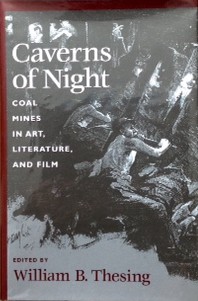Inspiring Older Readers
 posted on 02 Jul 2016
posted on 02 Jul 2016
Caverns of the Night : coal mines in art, literature and film ed. William B. Thesing
I have recently been doing some research into the ways in which predominantly middle-class artists have tended to eroticise working class occupations. As part of that research I rather stumbled across Caverns of the Night: coal mines in art, literature and film, an anthology of nineteen academic essays collated by William B. Thesing and published by the South Carolina Press.
I was originally drawn to Marsha Bryant’s excellent W.H.Auden and the Homoerotics of the 1930’s Documentary but I found myself staying to explore a wide range of essays that were a whole lot more accessible than I had anticipated. The essays are grouped in two distinct sections – one which covers England, Wales and France and a second which deals with the American scene.
I think the first thing that strikes the reader with this collection is just how wide and diverse the treatment of miners and mining is in Western art forms – fiction, documentary, poetry, painting and film-making are all represented here. The works discussed receive close attention and I would say that the overall quality of the textual and discourse analysis of the sources under examination are really first class. However, I was a little disappointed at both the lack of political context and social class analysis that I think is vital to really understanding the full cultural significance of the miner. That’s not to say that individual essays do not touch on these aspects of the subject but the collection quite specifically seems to privilege the aesthetic over the political or sociological and by doing so it feels like the broader picture is obscured.
However, as a collection, it has some really strong essays and I was particularly intrigued by a number of the contributions. Thesing’s own offering – Demonized Coal Miners and Domineering Muses in Sidney H. Sime’s Fantastic Illustrations - examines the work of the Victorian book illustrator, Sidney Sime, who is probably best known for his often bizarre fantasy drawings, especially those that appeared in the Idler Magazine. Whist there are clear influences in Sime’s work – Aubrey Beardsley and Richard Dadd spring to mind – Thesing argues that the key to his style lay in the fact that he was forced by his father to spend five years working in the Yorkshire coal mines. It is this, Thesing suggests, that provided the imagery and atmosphere that found its way into his illustrations.
I also liked Ina Rae Hark’s Blackfaced Rednecks : The problem of Backcountry Whites as Victims in John Sayles’s Matewan despite its absurdly clumsy title. Matewan is one of my favourite movies and so it was interesting to find out that the historical narrative of this miners’ strike was altered by Sayles to better reflect his own political ideology. I would, however, take issue with the rather lazy assumption that the American mining unions were built on violence – a claim not supported here by secondary evidence and which I know is contested by other analysts.
We have just celebrated the 30th anniversary of Tony Harrison’s seminal long poem, V, and at long last there is political pressure to pursue truth and justice for UK miners who were assaulted and falsely arrested during the 1984-5 miners’ strike. So it was also good to see Ed Madden’s essay The Language of the Graveyard included here because it is not afraid to take on both the political complexities of the poem and to deal with the ambiguities of the poets reaction to the vandalism of his fathers gravestone.
The book makes a surprisingly interesting and compelling read for anyone fascinated by the ways in which mines and miners have influenced our artistic and cultural landscape – you don’t have to be an academic to find yourself riveted by the multiplicity of ways in which the subject can be approached. Coal mining in the West, certainly in the UK, is now terminally compromised by the sustainable energy debate and so books like this become more and more important. They not only capture the extraordinary social, economic and environmental influence of a now vanishing industrial sector but they also remind us that this was about people ; about their lives, their aspirations and their communities.
Terry Potter
July 2016